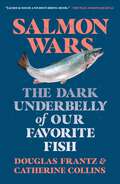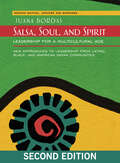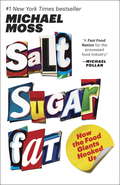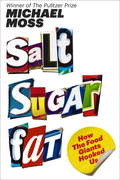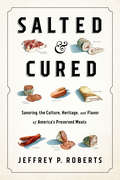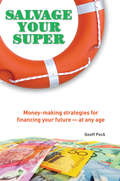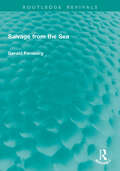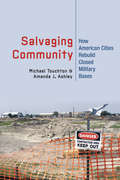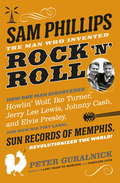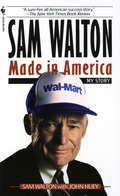- Table View
- List View
Sally Jameson: Valuing Stock Options in a Compensation Package (Abridged)
by Peter TufanoDetails a thinly disguised situation facing a recent Harvard MBA graduate who was forced by a prospective employer to place a dollar value on a grant of stock options. There are two objectives: 1) Serves as an introduction to option valuation, in which students have an opportunity to use market data to value an option in a realistic setting. 2) The setting permits a broader discussion of the wisdom of option-based incentive plans and the popular misconceptions of the value of option grants based on a widespread misunderstanding of how options work and how they are valued.
Salmon Wars: The Dark Underbelly of Our Favorite Fish
by Douglas Frantz Catherine CollinsA Pulitzer Prize-winning correspondent and a former private investigator dive deep into the murky waters of the international salmon farming industry, exposing the unappetizing truth about a fish that is not as good for you as you have been told.A decade ago, farmed Atlantic salmon replaced tuna as the most popular fish on North America’s dinner tables. We are told salmon is healthy and environmentally friendly. The reality is disturbingly different.In Salmon Wars, investigative journalists Douglas Frantz and Catherine Collins bring readers to massive ocean feedlots where millions of salmon are crammed into parasite-plagued cages and fed a chemical-laced diet. The authors reveal the conditions inside hatcheries, where young salmon are treated like garbage, and at the farms that threaten our fragile coasts. They draw colorful portraits of characters, such as the big salmon farmer who poisoned his own backyard, the fly-fishing activist who risked everything to ban salmon farms in Puget Sound, and the American researcher driven out of Norway for raising the alarm about dangerous contaminants in the fish. Frantz and Collins document how the industrialization of Atlantic salmon threatens this keystone species, endangers our health and environment, and lines the pockets of our generation's version of Big Tobacco. And they show how it doesn't need to be this way.Just as Eric Schlosser’s Fast Food Nation forced a reckoning with the Big Mac, the vivid stories, scientific research, and high-stakes finance at the heart of Salmon Wars will inspire readers to make choices that protect our health and our planet.
Salomon Brothers (A)
by Lynn Sharp PaineDescribes Salomon Brothers' recovery from the August 1991 Treasury auction scandal. Details the impact of the firm's disclosure of bidding improprieties and describes how the new management team, led by Warren Buffett and Deryck Maughan, guided the company through the ensuing crisis. The impact of the crisis is followed through the end of 1992. A rewritten version of an earlier case.
Salomon Brothers (B)
by Lynn Sharp PaineSupplements the (A) case. A rewritten version of an earlier case.
Salomon and the Treasury Securities Auction
by Dwight B. Crane Patrick MoretonSet in June 1991, two months prior to Salomon Brothers' announcement that the firm had violated the Treasury Department's rules governing the auctions of new Treasury securities. Salomon Vice Chairman John Meriwether must decide how to address problems that continue to appear in the management of the firm's government bond trading activities. In April 1991, one of his managers admitted that he had submitted an illegal auction bid in February 1991. Now, one month later, there is mounting speculation in the press that Salomon tried to corner the market for May 2-year notes. Structured to allow students to analyze the ethical, legal and managerial dimensions of John Meriwether's situation. Background information about the history of Salomon Brothers and the investment banking industry, the markets for government securities, and the regulation of securities dealers and brokers is interwoven with Meriwether's story. Accessible to individuals with and without experience in investment banking.
Salon Fundamentals Cosmetology, Resource for Your Cosmetology Career Exam Prep, 2nd Edition
by Pivot Point International StaffA Resource for preparation of Cosmetology Career Exam and Cosmetology Licensure Exam.
Salsa, Soul, and Spirit: Leadership for a Multicultural Age
by Juana BordasConsultant Bordas describes a multicultural model of leadership that incorporates traditional Latino, African American, and American Indian concepts and practices. She describes eight core leadership principles that are common to all three cultures. These include (for example) generosity, community conferred leadership, and universal kinship. The material is based in part on interviews conducted with such visionary leaders as Ada Deer (first woman to head the U.S. Bureau of Indian Affairs) and Raul Yzaguirre (founder of the Hispanic Association for Corporate Responsibility). Bordas is President of Mestiza Leadership International. Annotation ©2007 Book News, Inc., Portland, OR (booknews.com)
Salsa, Soul, and Spirit: Leadership for a Multicultural Age
by Juana BordasNEW EDITION, REVISED AND UPDATED One of America’s historic strengths is the ability to incorporate aspects from many different cultures to create a stronger whole. Our music, literature, sports, architecture, food, and fashion have all benefitted. But current leadership approaches are overwhelmingly written by White males and remain distressingly Eurocentric. Juana Bordas has set out to change this. In this influential book, she shows how incorporating Latino, Black, and American Indian approaches can enrich leadership and offers a more viable model for our expanding multicultural society.
Salt Harbor: Confidential Information for Brims
by Michael A. WheelerTwo-party negotiation involving a bed and breakfast and an incoming coffee chain.
Salt Harbor: Confidential Information for Brims
by Michael A. WheelerTwo-party negotiation involving a bed and breakfast and an incoming coffee chain.
Salt Harbor: Confidential Information for Easterly
by Michael A. WheelerTwo-party negotiation involving a bed and breakfast and an incoming coffee chain.
Salt Harbor: Confidential Information for Easterly
by Michael A. WheelerTwo-party negotiation involving a bed and breakfast and an incoming coffee chain.
Salt Lake Organizing Committee: 2002 Olympics
by H. Kent Bowen Courtney Purrington Bryce C. LapierreAfter two and a half years of effort, Fraser Bullock, COO of the 2002 Winter Olympics, faced projected deficits and post-9/11 security requirements only five months before the opening ceremony. Summarizes the organizational structure and processes put in place by Bullock and CEO Mitt Romney, as well as how they created systems and culture to endow effective working knowledge to the 90% of their staff who started working two weeks before the games began.
Salt Sugar Fat
by Michael Moss#1 NEW YORK TIMES BESTSELLERFrom a Pulitzer Prize-winning investigative reporter at The New York Times comes the explosive story of the rise of the processed food industry and its link to the emerging obesity epidemic. Michael Moss reveals how companies use salt, sugar, and fat to addict us and, more important, how we can fight back. In the spring of 1999 the heads of the world's largest processed food companies--from Coca-Cola to Nabisco--gathered at Pillsbury headquarters in Minneapolis for a secret meeting. On the agenda: the emerging epidemic of obesity, and what to do about it. Increasingly, the salt-, sugar-, and fat-laden foods these companies produced were being linked to obesity, and a concerned Kraft executive took the stage to issue a warning: There would be a day of reckoning unless changes were made. This executive then launched into a damning PowerPoint presentation--114 slides in all--making the case that processed food companies could not afford to sit by, idle, as children grew sick and class-action lawyers lurked. To deny the problem, he said, is to court disaster. When he was done, the most powerful person in the room--the CEO of General Mills--stood up to speak, clearly annoyed. And by the time he sat down, the meeting was over. Since that day, with the industry in pursuit of its win-at-all-costs strategy, the situation has only grown more dire. Every year, the average American eats thirty-three pounds of cheese (triple what we ate in 1970) and seventy pounds of sugar (about twenty-two teaspoons a day). We ingest 8,500 milligrams of salt a day, double the recommended amount, and almost none of that comes from the shakers on our table. It comes from processed food. It's no wonder, then, that one in three adults, and one in five kids, is clinically obese. It's no wonder that twenty-six million Americans have diabetes, the processed food industry in the U.S. accounts for $1 trillion a year in sales, and the total economic cost of this health crisis is approaching $300 billion a year. In Salt Sugar Fat, Pulitzer Prize-winning investigative reporter Michael Moss shows how we got here. Featuring examples from some of the most recognizable (and profitable) companies and brands of the last half century--including Kraft, Coca-Cola, Lunchables, Kellogg, Nestlé, Oreos, Cargill, Capri Sun, and many more--Moss's explosive, empowering narrative is grounded in meticulous, often eye-opening research. Moss takes us inside the labs where food scientists use cutting-edge technology to calculate the "bliss point" of sugary beverages or enhance the "mouthfeel" of fat by manipulating its chemical structure. He unearths marketing campaigns designed--in a technique adapted from tobacco companies--to redirect concerns about the health risks of their products: Dial back on one ingredient, pump up the other two, and tout the new line as "fat-free" or "low-salt." He talks to concerned executives who confess that they could never produce truly healthy alternatives to their products even if serious regulation became a reality. Simply put: The industry itself would cease to exist without salt, sugar, and fat. Just as millions of "heavy users"--as the companies refer to their most ardent customers--are addicted to this seductive trio, so too are the companies that peddle them. You will never look at a nutrition label the same way again."As a feat of reporting and a public service, Salt Sugar Fat is a remarkable accomplishment."--The New York Times Book ReviewFrom the Hardcover edition.
Salt Sugar Fat: How the Food Giants Hooked Us
by Michael MossFrom a Pulitzer Prize-winning investigative reporter at The New York Times comes the explosive story of the rise of the processed food industry and its link to the emerging obesity epidemic. Michael Moss reveals how companies use salt, sugar, and fat to addict us and, more important, how we can fight back. In the spring of 1999 the heads of the world's largest processed food companies--from Coca-Cola to Nabisco--gathered at Pillsbury headquarters in Minneapolis for a secret meeting. On the agenda: the emerging epidemic of obesity, and what to do about it. Increasingly, the salt-, sugar-, and fat-laden foods these companies produced were being linked to obesity, and a concerned Kraft executive took the stage to issue a warning: There would be a day of reckoning unless changes were made. This executive then launched into a damning PowerPoint presentation--114 slides in all--making the case that processed food companies could not afford to sit by, idle, as children grew sick and class-action lawyers lurked. To deny the problem, he said, is to court disaster. When he was done, the most powerful person in the room--the CEO of General Mills--stood up to speak, clearly annoyed. And by the time he sat down, the meeting was over. Since that day, with the industry in pursuit of its win-at-all-costs strategy, the situation has only grown more dire. Every year, the average American eats thirty-three pounds of cheese (triple what we ate in 1970) and seventy pounds of sugar (about twenty-two teaspoons a day). We ingest 8,500 milligrams of salt a day, double the recommended amount, and almost none of that comes from the shakers on our table. It comes from processed food. It's no wonder, then, that one in three adults, and one in five kids, is clinically obese. It's no wonder that twenty-six million Americans have diabetes, the processed food industry in the U.S. accounts for $1 trillion a year in sales, and the total economic cost of this health crisis is approaching $300 billion a year. In Salt Sugar Fat, Pulitzer Prize-winning investigative reporter Michael Moss shows how we got here. Featuring examples from some of the most recognizable (and profitable) companies and brands of the last half century--including Kraft, Coca-Cola, Lunchables, Kellogg, Nestlé, Oreos, Cargill, Capri Sun, and many more--Moss's explosive, empowering narrative is grounded in meticulous, often eye-opening research. Moss takes us inside the labs where food scientists use cutting-edge technology to calculate the "bliss point" of sugary beverages or enhance the "mouthfeel" of fat by manipulating its chemical structure. He unearths marketing campaigns designed--in a technique adapted from tobacco companies--to redirect concerns about the health risks of their products: Dial back on one ingredient, pump up the other two, and tout the new line as "fat-free" or "low-salt." He talks to concerned executives who confess that they could never produce truly healthy alternatives to their products even if serious regulation became a reality. Simply put: The industry itself would cease to exist without salt, sugar, and fat. Just as millions of "heavy users"--as the companies refer to their most ardent customers--are addicted to this seductive trio, so too are the companies that peddle them. You will never look at a nutrition label the same way again.From the Hardcover edition.
Salted and Cured: Savoring the Culture, Heritage, and Flavor of America's Preserved Meats
by Jeffrey RobertsFrom country ham to coppa, bacon to bresaola Prosciutto. Andouille. Country ham. The extraordinary rise in popularity of cured meats in recent years often overlooks the fact that the ancient practice of meat preservation through the use of salt, time, and smoke began as a survival technique. All over the world, various cultures developed ways to extend the viability of the hunt—and later the harvest—according to their unique climates and environments, resulting in the astonishing diversity of preserved meats that we celebrate and enjoy today everywhere from corner delis to white-tablecloth restaurants. In Salted and Cured, author Jeffrey P. Roberts traces the origins of today’s American charcuterie, salumi, and other delights, and connects them to a current renaissance that begins to rival those of artisan cheese and craft beer. In doing so, Roberts highlights the incredible stories of immigrant butchers, breeders, chefs, entrepreneurs, and other craftspeople who withstood the modern era’s push for bland, industrial food to produce not only delicious but culturally significant cured meats. By rejecting the industry-led push for “the other white meat” and reinvigorating the breeding and production of heritage hog breeds while finding novel ways to utilize the entire animal—snout to tail—today’s charcutiers and salumieri not only produce everything from country ham to violino di capra but create more sustainable businesses for farmers and chefs. Weaving together agriculture, animal welfare and health, food safety and science, economics, history, a deep sense of place, and amazing preserved foods, Salted and Cured is a literary feast, a celebration of both innovation and time-honored knowledge, and an expertly guided tour of America’s culinary treasures, both old and new.
Salutogenious Growth – Wachstum der Zukunft: Mut zur intelligenten Ökonomie und die Magie der kreativen Empathie
by Raimund SchwendnerSalutogenious Growth setzt sich mit innovativen sowie zukunftsweisenden Formen des Wachstums auseinander. Daraus leitet es Instrumentarien und Prozesse zur nachhaltigen Transformation ab. Diese überträgt die Grundlagen der Salutogenese in wirtschaftliches Denken, also in die Frage, welche aktiven Prozesse ökonomische "Gesundheit" erzeugen, und verknüpft sie mit der "Ingeniosity". Die besticht durch Scharfsinn, Einfallsreichtum und Vorstellungskraft sowie durch kreative Empathie. Im Mittelpunkt stehen die "Leadership Maturity", der nachhaltige Turnaround des General Managements und die Entwicklung von "lernenden Kennzahlen". Die ordnen der Kauf- und Investitionskraft eine Problemlöse-Stärke zu, um eine langfristige Wertschöpfung zu erzielen. Das verbindet ökonomische, ökologisch verantwortliche und soziale Innovationen. Es bildet den Mantel für hochkarätige technologische Innovationen und für eine "hochbegabte" Künstliche Intelligenz. Diese vermag komplexe Risiken zügig zu erkennen, ihnen vorzubeugen und sie zu "überholen". So profitiert der Homo oeconomicus von der besonderen Klugheit des Homo sapiens-sapiens. Daraus entstehen neuartige Formen der Personal- und Organisationsentwicklung und insbesondere der zukunftsfähigen Persönlichkeitsentwicklung.
Salvage Your Super: Money-Making Strategies for Financing your Future -- at any age
by Geoff PeckThe recent stock market crash saw a staggering $200 billion wiped off superannuation balances. Fortunately, you can do something about it. Salvage Your Super is a comprehensive guide to making the most of your super and retirement assets, regardless of your age or income. It offers sound advice on what to do with your super depending on your financial profile, and provides tangible solutions to help retirees reverse the recent downtreand in their funds without selling the farm. Inside you'll discover: how to calculate how much you will need in retirement to live the life you want age-specific tactics (whether you're in your 20s, 30s, 40s, 50s or 60s, or you're post-retirement) to get your super back on track accessible, easy-to-implement strategies that are appropriate for both now and the future how to maximize your returns and minimise fees and tax. So don't just sit back and wait for things to get better -- read this book and salvage your super!
Salvage from the Sea (Routledge Revivals)
by Gerald ForsbergSalvage from the Sea (1977) offers a fascinating insight into the interesting but complex and highly specialised profession of marine salvage and its associated disciplines. All aspects of the wide and varies field of marine salvage are covered and discussed in detail.
Salvaging Community: How American Cities Rebuild Closed Military Bases
by Michael Touchton Amanda J. AshleyAmerican communities face serious challenges when military bases close. But affected municipalities and metro regions are not doomed. Taking a long-term, flexible, and incremental approach, Michael Touchton and Amanda J. Ashley make strong recommendations for collaborative models of governance that can improve defense conversion dramatically and ensure benefits, even for low-resource municipalities. Communities can't control their economic situation or geographic location, but, as Salvaging Community shows, communities can control how they govern conversion processes geared toward redevelopment and reinvention.In Salvaging Community, Touchton and Ashley undertake a comprehensive evaluation of how such communities redevelop former bases following the Department of Defense's Base Realignment and Closure (BRAC) process. To do so, they developed the first national database on military redevelopment and combine quantitative national analyses with three, in-depth case studies in California. Salvaging Community thus fills the void in knowledge surrounding redevelopment of bases and the disparate outcomes that affect communities after BRAC. The data presented in Salvaging Community points toward effective strategies for collaborative governance that address the present-day needs of municipal officials, economic development agencies, and non-profit organizations working in post-BRAC communities. Defense conversion is not just about jobs or economic rebound, Touchton and Ashley argue. Emphasizing inclusion and sustainability in redevelopment promotes rejuvenated communities and creates places where people want to live. As localities and regions deal with the legacy of the post-Cold War base closings and anticipate new closures in the future, Salvaging Community presents a timely and constructive approach to both economic and community development at the close of the military-industrial era.
Sam Barnstable and Blue Sky Radio Devices
by G. Felda Hardymon Ann LeamonThese three short vignettes depict investment professionals considering difficult financings for companies in their portfolios. For one reason or another, each company has under-performed expectations. Should the protagonist recommend that the firm participate or not, or should he try to revise it? Can the firm exercise any influence, and are the potential gains worth the time and effort that will be required?
Sam Phillips: The Man Who Invented Rock 'n' Roll
by Peter GuralnickRock 'n' roll was born in rural Alabama, 1923, in the form of Sam Phillips, the youngest son of a large family living in a remote colony called the Lovelace Community. His father had a gift for farming, which was brought to an end by the Depression. His mother picked guitar and showed the kind of forbearance that allowed her to name her son after the doctor who delivered him drunk and then had to be put to bed himself. And yet from these unprepossessing origins, in 1951 Phillips made what is widely considered to be the first rock 'n' roll record, Ike Turner and Jackie Brenston's 'Rocket 88'. Just two years later a shy eighteen-year-old kid with sideburns, fresh out of high school, wandered into his recording studio to make a record 'for his mother', secretly hoping that it might somehow get him noticed. His name was Elvis Presley. Elvis's success, and the subsequent triumph of rock 'n' roll, was initially propelled to an almost astonishing degree by a limited number of releases by Carl 'Blue Suede Shoes' Perkins, Johnny Cash and Jerry Lee Lewis - all from this tiny, one-man label. An engaging mix of biography and anecdote, Peter Guralnick's book brilliantly recreates one shining moment in the history of popular culture. And Sam Phillips was the man who brought it all about.
Sam Walton
by Sam Walton John HueyMeet a genuine American folk hero cut from the homespun cloth of America's heartland: Sam Walton, who parlayed a single dime store in a hardscrabble cotton town into Wal-Mart, the largest retailer in the world. The undisputed merchant king of the late twentieth century, Sam never lost the common touch. Here, finally, inimitable words. Genuinely modest, but always sure if his ambitions and achievements. Sam shares his thinking in a candid, straight-from-the-shoulder style. In a story rich with anecdotes and the "rules of the road" of both Main Street and Wall Street, Sam Walton chronicles the inspiration, heart, and optimism that propelled him to lasso the American Dream.

